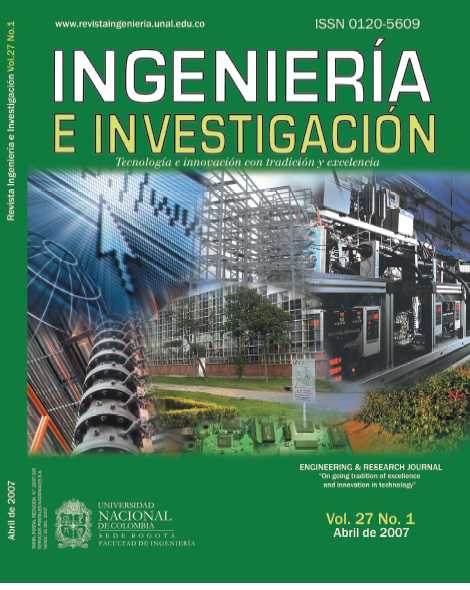A new method for designing floor slabs on grade due to the difficulty of applying simplified design methods, amongst them being the Portland Cement Association (PCA) and Wire Reinforcement Institute (WRI) methods
Un nuevo método de diseño de losas para pisos industriales ante la inaplicabilidad de los métodos simplificados de diseño, entre ellos los de la Portland Cement Association (Pca) y Wire Reinforcement Institute (WRI)
DOI:
https://doi.org/10.15446/ing.investig.v27n1.14786Keywords:
floor slab on grade, Portland Cement Association, Wire Reinforcement Institute, slab design on grade, floor design, industrial floor slab, concrete floor, concrete slab on grade, pavement, rigid pavement (en)placas de piso sobre terreno, Portland Cement Association, Wire Reinforcement Institute, diseño de losas sobre terreno, diseño de pisos, placas de pisos industriales, losas de pisos industriales, pisos de concreto (es)
Downloads
This article presents a methodology for designing slabs on grade for industrial floors where there is an eccentricity between the slab centroid and the gravity center loads of the loaded axle of forklift trucks travelling over the floor. An example was used for analyzing how Portland Cement Association (PCA) and the Wire Reinforcement Institute (WRI) methods are inadequate for designing floors subjected to this condition. The new proposal for designing slabs on grade for industrial floors has been called the Camero method. An example of an industrial floor designed to be capable of sustaining an infinite number of load applications (or 50-year life) was compared to the results of the Camero method and PCA and WRI’s simplified methods. Industrial floors should be capable of sustaining an infinite number of load applications (50-year lite) if designed with the Camero method; on the other hand, if designed using PCA and WRI methods they will only last one year (in this example the number of axle load applications in a 1-year period was equal to the number of allowable repetitions) because they will not be able to sustain an infinite number of load applications. It was concluded that designing plain concrete slabs (without reinforcement) on grade according to PCA and the WRI methods leads to slab fatigue, even though extreme fiber stress should not exceed 50 percent (50%) of static modulus of concrete rupture and slabs should sustain an infinite number of load repetitions (infinite amount of forklift truck traffic) were considered parameters in their design.
Se presenta una metodología para el diseño de losas sobre terreno para pisos industriales en donde hay excentricidad entre el centroide de la losa y el centro de gravedad de las cargas del eje cargado del montacargas que transita sobre el piso. Mediante un ejemplo se analiza cómo los métodos de diseño de pisos de la Portland Cement Association (PCA) y la Wire Reinforcement Institute (WRI) son inadecuados para el diseño de pisos sometidos a esta condición. El nuevo método propuesto para diseñar pisos industriales ha sido llamado Camero. Mediante un ejemplo, un piso industrial es diseñado para ser capaz de admitir un número infinito de aplicaciones de carga (o un periodo de vida útil del piso de 50 años), comparando los resultados del método Camero y los simplificados de la PCA y la WRI. El piso industrial será capaz de admitir un número infinito de aplicaciones de carga (50 años) si es diseñado con el método Camero. De otra manera: si es diseñado por los métodos de la PCA y la WRI únicamente durará un año (En este ejemplo, en el periodo de un año el número de aplicaciones del eje cargado es igual al número de repeticiones admisibles), por eso el piso industrial no será capaz de admitir un número infinito de aplicaciones de carga. Concluimos que el diseño de losas sobre terreno de concreto simple (sin refuerzo), de acuerdo con la metodología de la PCA y la WRI, conduce a losas diseñadas a fatiga, a pesar de haber considerado en el diseño que el esfuerzo en las fibras superiores no excedería el 50% del módulo de rotura del concreto y que admitirían un número infinito de repeticiones de carga (número infinito de tránsito del montacargas de diseño).
References
Yoder, E.J. and Witczak, M.W., Principles of Pavement Design., 2nd. edition, John Wiley & Sons, Inc., New York, 1975. DOI: https://doi.org/10.1002/9780470172919
Ringo, B.C. and Anderson R.B., Designing Floor Slabs On Grade., 2nd. edition, Illinois, The Aberdeen Group, 1996.
Camero, H.E., Diseño y Construcción de placas de contrapiso industriales sin juntas en concreto reforzado., Asociación de Ingenieros Civiles de la Universidad Nacional de Colombia’s Journal, No. 31, Junio, 2002, pp. 12-13.
How to Cite
APA
ACM
ACS
ABNT
Chicago
Harvard
IEEE
MLA
Turabian
Vancouver
Download Citation
CrossRef Cited-by
1. Arnulfo Luévanos-Rojas, Blanca Lucia Estrada-Mendoza, Mónico Juárez-Ramírez. (2024). Estudio comparativo para áreas mínimas en contacto con el suelo de zapatas aisladas rectangulares y circulares trabajando parcialmente bajo compresión. Boletín de Ciencias de la Tierra, (55), p.85. https://doi.org/10.15446/rbct.n55.111624.
Dimensions
PlumX
Article abstract page views
Downloads
License
Copyright (c) 2007 Hugo Ernesto Camero Sanabrial

This work is licensed under a Creative Commons Attribution 4.0 International License.
The authors or holders of the copyright for each article hereby confer exclusive, limited and free authorization on the Universidad Nacional de Colombia's journal Ingeniería e Investigación concerning the aforementioned article which, once it has been evaluated and approved, will be submitted for publication, in line with the following items:
1. The version which has been corrected according to the evaluators' suggestions will be remitted and it will be made clear whether the aforementioned article is an unedited document regarding which the rights to be authorized are held and total responsibility will be assumed by the authors for the content of the work being submitted to Ingeniería e Investigación, the Universidad Nacional de Colombia and third-parties;
2. The authorization conferred on the journal will come into force from the date on which it is included in the respective volume and issue of Ingeniería e Investigación in the Open Journal Systems and on the journal's main page (https://revistas.unal.edu.co/index.php/ingeinv), as well as in different databases and indices in which the publication is indexed;
3. The authors authorize the Universidad Nacional de Colombia's journal Ingeniería e Investigación to publish the document in whatever required format (printed, digital, electronic or whatsoever known or yet to be discovered form) and authorize Ingeniería e Investigación to include the work in any indices and/or search engines deemed necessary for promoting its diffusion;
4. The authors accept that such authorization is given free of charge and they, therefore, waive any right to receive remuneration from the publication, distribution, public communication and any use whatsoever referred to in the terms of this authorization.



























